THE PALIK SERIES (edited by Brian Taves)
Brian Taves talks about the series in this interview.
TITLES
- Volume 1 — The Marriage of a Marquis
- Volume 2 — Shipwrecked Family: Marooned with Uncle Robinson
- Volume 3 — Mr. Chimp, and Other Plays
- Volume 4 — The Count of Chanteleine: A Tale of the French Revolution
- Volume 5 — Vice, Redemption and the Distant Colony
- Volume 6 — Around the World in 80 Days — The 1874 Play
- Volume 7 — Bandits & Rebels
- Volume 8 — Golden Danube
- Volume 9 — A Priest in 1835
- Volume 10 — The Castles of California
- Volume 11 — Scheherazade’s Last Night and Other Plays
- Volume 12 — Worlds Known and Unknown
Volume 1 — The Marriage of a Marquis
Foreword by Brian Taves; Introduction by Walter James Miller; The Marriage of Mr. Anselme des Tilleuls translated by Edward Baxter, with a preface and notes by Jean-Michel Margot, afterword by Edward Baxter; Appendix: Jédédias Jamet, or The Tale of an Inheritance translated, and with a preface and annotations, by Kieran M. O’Driscoll.
Available at Amazon.com in paperback and Kindle editions and reviewed there.
Foreword by Brian Taves; Introduction by Walter James Miller; The Marriage of Mr. Anselme des Tilleuls translated by Edward Baxter, with a preface and notes by Jean-Michel Margot, afterword by Edward Baxter; Appendix: Jédédias Jamet, or The Tale of an Inheritance translated, and with a preface and annotations, by Kieran M. O’Driscoll.
Available at Amazon.com in paperback and Kindle editions and reviewed there.
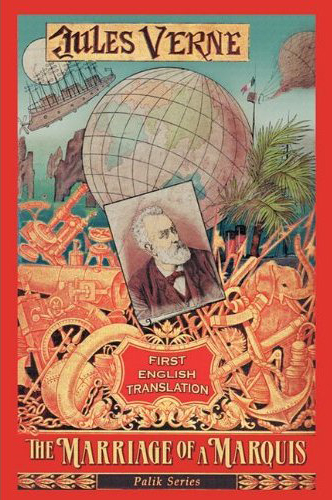
Jules Verne is the acclaimed author of such pioneering science fiction as 20,000
Leagues Under the Sea and Journey to the Center of the Earth.
Yet he also wrote much more, including stories never before translated into English,
which are presented for the first time in the Palik series, under the auspices of
the North American Jules Verne Society. Foreshadowing such classics as Around the
World in 80 Days, this inaugural volume focuses on two of Verne’s
earliest humorous stories, The Marriage of Mr. Anselme des Tilleuls and
Jédédias Jamet, or The Tale of an Inheritance. Translation
is provided by Edward Baxter and Kieran O’Driscoll, two of the leading Verne
experts; critical commentary examines both stories, and scholars explore why some
of the author’s stories were overlooked for so many years.
“I am a Jules Verne reader and collector. As such, I deeply appreciate the new editions of Verne being published by BearManor Fiction in its Palik Series. The most recent volume The Marriage of a Marquis features a wealth of extras, starting with essays by three of the leading Verne scholars of our time: Brian Taves, the late Walter James Miller, and Jean-Michel Margot, followed by commentary by translator Edward Baxter and an additional Verne fragment translated by Kieran M. O’Driscoll. The paperback’s gorgeous cover resembles one of the classic French Hetzel editions. Jules Verne was more than just a writer of boys’ adventures and his oeuvre extends way beyond the four or five classics that everyone knows about. He’s a writer well worth exploring and rediscovering.”
— Michael Dirda, The Washington Post
“The story that gives this volume its title introduces English readers to a clever young writer’s portraits of two memorable twits living in France’s equivalent of ancient Abdera. Not the least of its attractions is Verne’s witty demonstration of the power of Latin over matters of the heart.”
— Martin M. Winkler, Professor of Classics, George Mason University
“I thought I knew Verne, but I had no idea how wonderful his sense of humor was until I read the first. Bravo! ”
— T.E. MacArthur, author of The Volcano Lady series, TreasureLine Publishing
Volume 2 — Shipwrecked Family: Marooned with Uncle Robinson
Translated by Sidney Kravitz; Introduction by Brian Taves
Available at Amazon.com in a paperback edition and reviewed there.
Translated by Sidney Kravitz; Introduction by Brian Taves
Available at Amazon.com in a paperback edition and reviewed there.
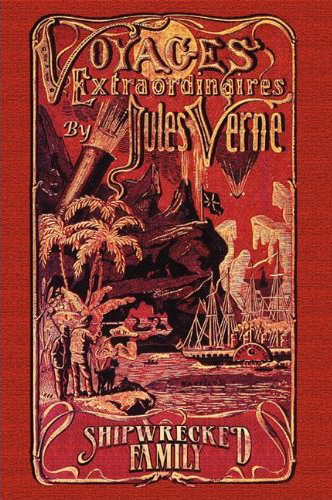
Castaway by pirates on a deserted island … without tools or supplies to survive
… a mother and her children have only a kindly old sailor to help. But what
explains the strange flora and fauna they find? The second volume in the Palik series,
presented by the North American Jules Verne Society, offers another story never
before published in English. Shipwrecked Family was rejected by Verne’s
publisher, so rather than finish it, he began to rewrite it with new characters—and
that became the classic, The Mysterious Island, where Captain Nemo made
his last appearance. Here, then, is Verne’s first draft of that novel, one
which is very different from the book that it became. Expert translation is provided
by Sidney Kravitz, also translator of the definitive modern edition of The Mysterious
Island.
“Many thanks … I was very pleased you included a dedication to me as well as a still from our film. It is fascinating to read how some of his books actually got started.”
— Ray Harryhausen, special effects wizard of the 1961 film “The Mysterious Island”
Volume 3 — Mr. Chimp, and Other Plays
(The Knights of the Daffodil, Mr. Chimpanzee, The Adoptive Son, and Eleven Days of Siege)
Translated by Frank Morlock; Introduction by Jean-Michel Margot
Available at Amazon.com in paperback and Kindle editions and reviewed there.
(The Knights of the Daffodil, Mr. Chimpanzee, The Adoptive Son, and Eleven Days of Siege)
Translated by Frank Morlock; Introduction by Jean-Michel Margot
Available at Amazon.com in paperback and Kindle editions and reviewed there.

Long before Jules Verne stories had formed the basis for such movies
as Around the World in 80 Days, many of his plays were theatrical blockbusters on the
19th century stage. Expert scholarly research introduces four of Verne’s
plays written in his youth, translated by Frank Morlock. Verne’s themes range
from romantic comedies to a scientist’s discovery that there may not be such
a difference between human and ape after all!
Verne’s collaborators on the four plays in this volume include Michel Carré, Charles Wallut, and Victorien Sardou.
Verne’s collaborators on the four plays in this volume include Michel Carré, Charles Wallut, and Victorien Sardou.
“A very nice and well documented edition: - all my congratulations!”
— Volker Dehs, Renowned Jules Verne expert and biographer
Volume 4 — The Count of Chanteleine: A Tale of the French Revolution
Translated by Edward Baxter; Introduction by Brian Taves; Notes and maps by Garmt de Vries-Uiterweerd; Afterword by Volker Dehs
Available at Amazon.com in hardcover, paperback, Kindle and Audible.com editions and reviewed there. The Audible.com version is a professional reading by vocal artist Fred Frees. Here is a YouTube ad for the recording and you can hear of sample of the reading here.
Translated by Edward Baxter; Introduction by Brian Taves; Notes and maps by Garmt de Vries-Uiterweerd; Afterword by Volker Dehs
Available at Amazon.com in hardcover, paperback, Kindle and Audible.com editions and reviewed there. The Audible.com version is a professional reading by vocal artist Fred Frees. Here is a YouTube ad for the recording and you can hear of sample of the reading here.
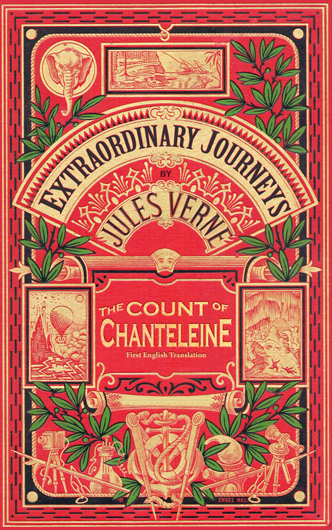
This is a novel for everyone who has thrilled to the adventures
of A Tale of Two Cities, The Scarlet Pimpernel, or Scaramouche. A nobleman,
the Count of Chanteleine, leads a rebellion against the revolutionary French government.
While he fights for the monarchy and the Catholic Church, his home is destroyed
and his wife murdered by the mob. Chanteleine must struggle to save his daughter
from the threat of the guillotine. This exciting swashbuckler is also a meticulous
historical recreation of a particularly bloody episode in the Reign of Terror.
The Count of Chanteleine is the first English translation of this Jules Verne story, with expert translation by Edward Baxter, with critical commentary by an international team of Verne experts.
The Count of Chanteleine is the first English translation of this Jules Verne story, with expert translation by Edward Baxter, with critical commentary by an international team of Verne experts.
“The Count of Chanteleine, Verne’s foray into historical fiction is a combination of The Scarlet Pimpernel, A Tale of Two Cities, or Scaramouche…. Verne was a master of plot twists and a thundering pace. It’s downright cinematic and you may polish it off in a single session.
“The translator did his task well; it’s easy to read. There’s suitable illustrations and handy maps. Useful notes by two Verne scholars, and an introduction make it easy to understand the history that the background to all this Revolutionary derring-do. It could be a fine gift.”
— “Adventure with Jules Verne,” Napoleonic Historical Society Newsletter, May-June 2012, p. 25.
— “Admired by Sabatini” by Ruth Heredia, poet and Rafael Sabatini biographer, blog of February 23, 2013.
“The Count of Chanteleine belongs to the rich literary tradition inspired by the French Revolution both in France and in England. As the editor notes, it adds to the romantic view of the Revolution illustrated by Dickens’s A Tale of Two Cities, and Orczy’s immensely popular adventures of the Scarlet Pimpernel, which were to delight early twentieth-century readers. With its careful annotation and afterword by well-known Verne scholars, The Count of Chanteleine is an ideal text for readers of French fiction and particularly for those interested in nineteenth-century interpretations of the French Revolution.
Like other titles published in the series, the book includes the original illustrations and reproduces the famous Hetzel cover.”
— Marie-Hélène Huet, review in French Forum, Vol. 28, Nos. 1-2, 2013, 288-290.
Volume 5 — Vice, Redemption and the Distant Colony
(Fact-Finding Mission, Pierre-Jean and The Fate of Jean Morénas)
Translated, with an introduction and notes, by Kieran M. O’Driscoll
Available at Amazon.com in paperback and Kindle editions and reviewed there.
(Fact-Finding Mission, Pierre-Jean and The Fate of Jean Morénas)
Translated, with an introduction and notes, by Kieran M. O’Driscoll
Available at Amazon.com in paperback and Kindle editions and reviewed there.
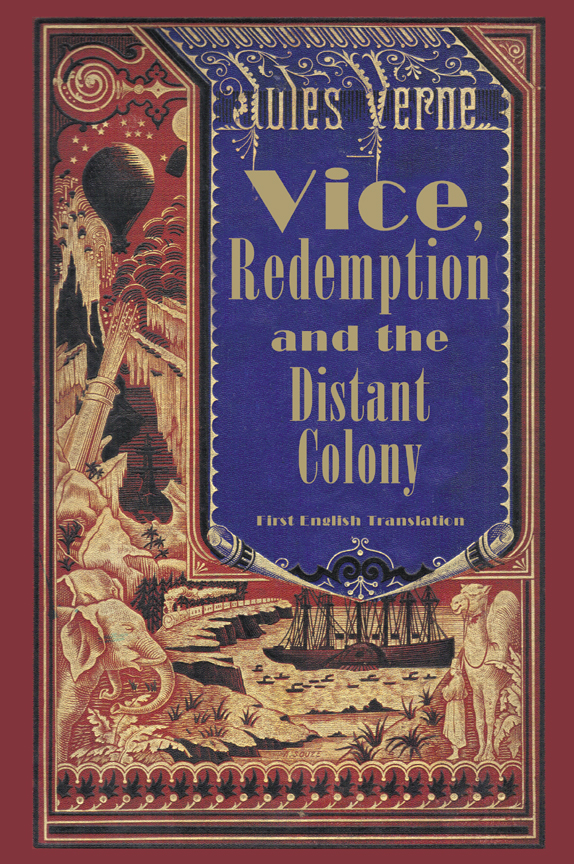
Literary fraud or filial devotion? This is the question at the heart
of a firestorm that erupted two decades ago. Manuscripts and letters were discovered that proved
that Jules Verne’s son, Michel, significantly revised over a dozen of the
stories published under his father’s name, and even originated some of them
himself. It was a collaboration that had begun while both were still alive, and
continued as Michel saw to posthumous publication many of his father’s stories.
In this volume can be found one story as it was written by Jules (as Pierre-Jean),
revised by his son (into The Somber Fate of Jean Morénas)—and
subsequently brought to the silent movie screen in yet another version by Michel.
Also in these pages is the first English translation of a novel Jules began, Fact-Finding
Mission, but which his son finished, and has hitherto only been available
in the completed version by Michel. The English version and notes are by a leading
authority on Verne translations, Kieran O’Driscoll.
“Kieran O’Driscoll served as the translator for this fine volume and was also responsible for its critical notes which offer a refreshingly unbiased and nonjudgmental view on the ‘familial collaboration’ between Jules and Michel Verne and their often controversial literary (and cinematic) legacy.”
— Arthur B. Evans, Editorial, Verniana — Volume 5 (2012-2013)
Volume 6 — Around the World in 80 Days — The 1874 Play
by Jules Verne and Adolphe D’Ennery; Introduction by Philippe Burgaud, with Jean-Michel Margot and Brian Taves; with Verne’s “The Meridians and the Calendar” translated and annotated by Jean-Louis Trudel; Appendix: The Play on Screen by Brian Taves
Available at Amazon.com in a paperback edition and reviewed there.
by Jules Verne and Adolphe D’Ennery; Introduction by Philippe Burgaud, with Jean-Michel Margot and Brian Taves; with Verne’s “The Meridians and the Calendar” translated and annotated by Jean-Louis Trudel; Appendix: The Play on Screen by Brian Taves
Available at Amazon.com in a paperback edition and reviewed there.

Verne’s most famous novel was originally conceived as a novel—and
had its greatest 19th century success as a stage hit. Running for literally
thousands of performances in many different countries, including the United States,
here is the original playscript, translated directly from the French by the producers
of the original Broadway presentation. Like filmmakers after him, Verne understood
the need to adapt his novel for a new medium, and enhance the dramatic spectacle.
In collaboration with Adolphe d’Ennery, Verne created a distinct variation
on the novel, with many different characters and episodes. All of those who love
the book will want to read Verne’s stage version. Included are an introduction
by Verne scholar Philippe Burgaud and the first translation of Verne’s essay,
“The Meridians and the Calendar,” explaining how Phileas Fogg accomplished
his feat despite actually traveling 81 days.
“Once again we recommend this latest publication in this series; it’s for anyone who enjoys the imagination of Jules Verne.”
— J. Randolph Cox, “The Reference Shelf,” Dime Novel Round-Up, Vol. 82, Summer 2013, 73-74.
“I heartily recommend Verne’s original play to everyone--it is far different than the novel and the history of the play’s success worldwide is a large slice of American history.”
— John Goodwin, Emmy Award-winning Makeup Artist and Verne enthusiast, letter to Palik Series Editor
“Jules Verne, of course, wrote in French and the compilers of this volume have gone to amazingly great lengths to obtain and present original 19th century English translated material. They also supplied a duo of enlightening essays outlining the metamorphosis of the yarn be it on printed page, on stage or on screen. An abundance of rare engravings, postcards, caricatures, photos, advertisements, programs, posters and even stereograms round out the supplemental material.
In Americanized theatrical form, ‘Around the World in 80 Days’ is a fine read as both an introduction to the famed exploits of Phileas Fogg and as a fresh look at an old favorite. It would even make a good first taste of Verne period.
A genuine treat.”
— Steven A. Joyce, review on Amazon, 11 Apr 2013
“Most volumes in this series, a labor of love by experts on Jules Verne, focus on showcasing Verne’s depth and breadth as a writer. This one certainly does that, but it also adds a fascinating new dimension: Verne as a multimedia phenomenon.
Just as most Americans today know him mostly from Hollywood adaptations, most people in his own time and place knew Verne from the spectacular, special-effects-filled stage plays he made out of his novels. This book’s introductory material describes how Verne adapted ‘Around the World in 80 Days’ into a long-running international hit with help from a colorful character indeed, a whiz kid showman called Adolphe D’Ennery. The heart of the book is devoted to a faithful vintage translation of their adaptation, complete with 19th century engravings of the show and bookended with other visual memorabilia. The result is a highly effective evocation of what must have been a thrilling production: one can almost smell the gas fumes from the footlights, feel the excitement run through the house at every scenic surprise; hear the Parisians applaud as the curtain drops.
Most exciting of all, however, is discovering how Verne and D’Ennery twisted and tugged at the well-known novel to make it work on the stage. Just as every Hollywood producer has done, they made significant changes, including new major characters and scenes. Some of the changes show their age all too clearly; the play is nowhere near as fluid or believable as the novel, and one uncomfortable bit involves a blackface disguise. On the other hand, many of the add-ons work so well that their theatricality leaps off the page; one of the added subplots, involving a rival eccentric traveling with Phileas Fogg, furnishes not only lots of snappy banter but also some highly touching moments. And the book finishes off with two extra bonuses: a rarely published essay by Verne himself about Fogg’s achievement, and an engrossing new article revealing that the stage adaptation was itself adapted twice to yet another medium, the 20th-century screen.
At Amazon’s request, and in the interest of full disclosure, I should note in passing that I’m connected to the Verne society that put this book together and that I got a chance to preview it gratis (though I was not involved in its production and do not stand to profit by it). However, in this case, I believe my personal affection for Verne is beside the point; with its fascinating playscript centerpiece and evocative extra material, this volume should delight not only the writer’s fans, but anyone interested in how creative works are adapted and repurposed for new media. Which, in today’s cultural climate of reboots, remixes, and mashups of every kind, should be just about everybody.”
— Alex Kirstukas, “Bravo!”, review on Amazon, 11 Feb 2014
“Jules Verne fans will enjoy this translation of his stage adaptation, and best of all, the publisher has included a tantalizing set of extras, including nineteenth century engravings of the show and highly detailed elaborations of the back stories associated with the play. For a frame of reference, editor Brian Taves provides an analyses of various film versions. If you’ve enjoyed the well-known novel or any of the film adaptations, you’ll doubly enjoy the way Verne weaves new characters and events into the famous story, and you can easily see how the play could entice theatergoers even today.”
— George Larkin, “Jules Verne fans will enjoy this translation of his stage adaptation”, review on Amazon, 1 Feb 2016
Volume 7 — Bandits & Rebels
(“San Carlos,” The Siege of Rome, with “Future of the Submarine;” Appendix: Martin Paz, or The Pearl of Lima, the 1852 translation of the original French edition.)
Translated by Edward Baxter; Introduction by Daniel Compère, Translated by Jean-Michel Margot and Brian Taves
Available at Amazon.com in paperback and reviewed there.
(“San Carlos,” The Siege of Rome, with “Future of the Submarine;” Appendix: Martin Paz, or The Pearl of Lima, the 1852 translation of the original French edition.)
Translated by Edward Baxter; Introduction by Daniel Compère, Translated by Jean-Michel Margot and Brian Taves
Available at Amazon.com in paperback and reviewed there.
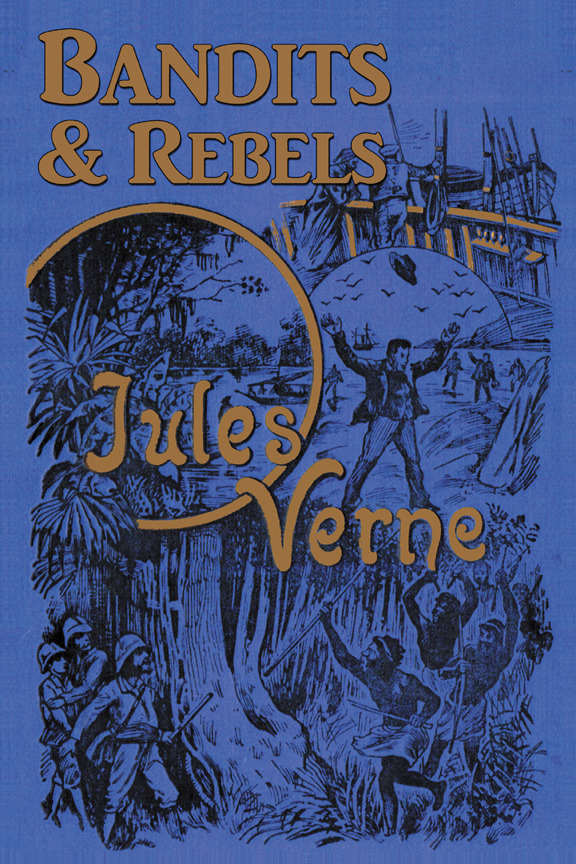
The Nautilus, the submarine of the outlaw Captain Nemo
in 20,000 Leagues Under the Sea, was not the first undersea craft imagined by
the prophetic author! A decade before that classic, Jules Verne wrote “San
Carlos,” telling of a Spanish smuggler who evades authorities with a vehicle
that can dive beneath the surface of the waves.
Accompanying this story is The Siege of Rome, a historical adventure in the Alexandre Dumas tradition, recounting a romance of love and betrayal as French forces retake Rome from the Italian revolutionaries of Garibaldi in 1849.
These two Verne stories are both published here in English for the first time, after acclaim from readers in France, Russia, Spain, Turkey, Hungary, the Czech Republic, and even China.
Here is a note series editor Brian Taves posted on Facebook on “Jules Verne’s Submarines”.
Here is a link to pages from the manuscript to “San Carlos”.
Accompanying this story is The Siege of Rome, a historical adventure in the Alexandre Dumas tradition, recounting a romance of love and betrayal as French forces retake Rome from the Italian revolutionaries of Garibaldi in 1849.
These two Verne stories are both published here in English for the first time, after acclaim from readers in France, Russia, Spain, Turkey, Hungary, the Czech Republic, and even China.
Here is a note series editor Brian Taves posted on Facebook on “Jules Verne’s Submarines”.
Here is a link to pages from the manuscript to “San Carlos”.
“It’s a fascinating book, especially Verne’s ruminations about the future of submarine warfare.”
— Larry Brooks, Disney’s 20,000 Leagues Yahoo group moderator
“The admirers of the writings of Jules Verne are dedicated indeed: the North American Jules Verne Society www.najvs.org is publishing a long series of his books, plays, and articles, many translated into English for the first time. BANDITS & REBELS (Albany: BearManor Fiction, 2013; 214 pp., $19.95) includes his ‘The Siege of Rome’ (a historical adventure in the tradition of Alexandre Dumas), with series editor Brian Taves’ comment that Verne, in 1857, reviewed a painting with that title by Horace Vernet, noted as a relation of Sherlock Holmes.
Conan Doyle also admired Verne’s works, and read some of them in French at Stonyhurst at the age of 14, encountering the Nautilus long before he wrote ‘Danger!’ (1914). BANDITS & REBELS also has the first story (‘San Carlos’) Verne wrote about submarines, long before he wrote TWENTY THOUSAND LEAGUES UNDER THE SEA.”
— Renowned Sherlockian Peter E. Blau’s newsletter Scuttlebutt from the Spermaceti Press, Feb 2014
“The Palik series continues its mission to recover little-known Verne stories and in that it has been extremely successful. Recommended to anyone interested in the works of a master storyteller.”
— J. Randolph Cox, “The Reference Shelf,” Dime Novel Round-Up, Vol. 83, Summer 2014, 81-82.
Volume 8 — Golden Danube
Translated, with an introduction and notes, by Kieran M. O’Driscoll
Available at Amazon.com in hardcover, paperback and Kindle editions and reviewed there.
Translated, with an introduction and notes, by Kieran M. O’Driscoll
Available at Amazon.com in hardcover, paperback and Kindle editions and reviewed there.
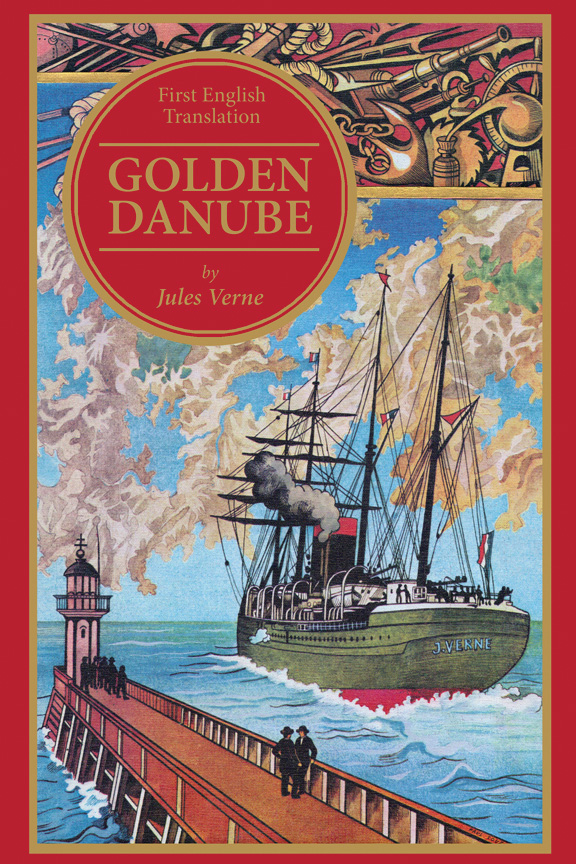
Verne’s “Extraordinary Journeys” often used the
travelogue mode, and here the author offers a voyage down the entire length of the
Danube, from Germany to the Black Sea. However, rather than the placid “blue”
Danube of classical conception, the author offers one which is golden, in multiple
ways. Smugglers are operating along the river, with the police in pursuit, and
the hero is a champion fisherman who is abducted and forced to prove his courage.
“A true ‘time lost’ literary treasure, this newly available work of the legendary French author, Jules Verne, ‘Golden Danube’, is an extraordinarily entertaining novel that has stood up well to the test of time. Ably translated into English by Kieran M. O’Driscoll, and under the editorial aegis of the North American Jules Verne Society in the person of Brian Taves, ‘Golden Danube’ is a ‘must read’ for the legion of Jules Verne fans and will prove to be an enduringly popular addition to personal and community library collections.”
— Midwest Book Review, Reviewer’s Bookwatch — Mason’s Bookshelf, Vol. 14, No. 4, April 2014
“Kieran M. O’Driscoll’s translation is very good and extremely faithful to Verne’s original text…. reads quite smoothly … I also found O’Driscoll’s 36-page introduction to be truly topnotch, not only instructive and critically aware but also … ideologically balanced. It provides the reader with an in depth look at the book’s publishing history, its major themes and characters, its possible homoerotic undertones, its humor ….”
— Arthur B. Evans, “Another Verne Manuscript Translated,” Science Fiction Studies, 41 (2014), p. 680.
Golden Danube is truly an “extraordinary voyage” as the hero travels on the Danube, a river that Verne takes some pains to explain to the reader is not blue as the composer Strauss called it, but yellow, and therefore the title he gave to this book is correct…. This is part an adventure story and part a travelogue with a mystery thrown in for good measure…. This little-known posthumous novel shows little sign of it being the work of a man past his prime, though Ilia Krusch’s journey down the Danube is also Verne’s journey through the last years of his life.
— J. Randolph Cox, “The Reference Shelf,” Dime Novel Round-Up, Vol. 85, Fall 2016, 124-125.
Volume 9 — A Priest in 1835
Translated with an introduction and notes, by Danièle Chatelain and George Slusser
Hardcover Limited Edition now available at BearManor Media.
Available at Amazon.com in paperback.
Translated with an introduction and notes, by Danièle Chatelain and George Slusser
Hardcover Limited Edition now available at BearManor Media.
Available at Amazon.com in paperback.
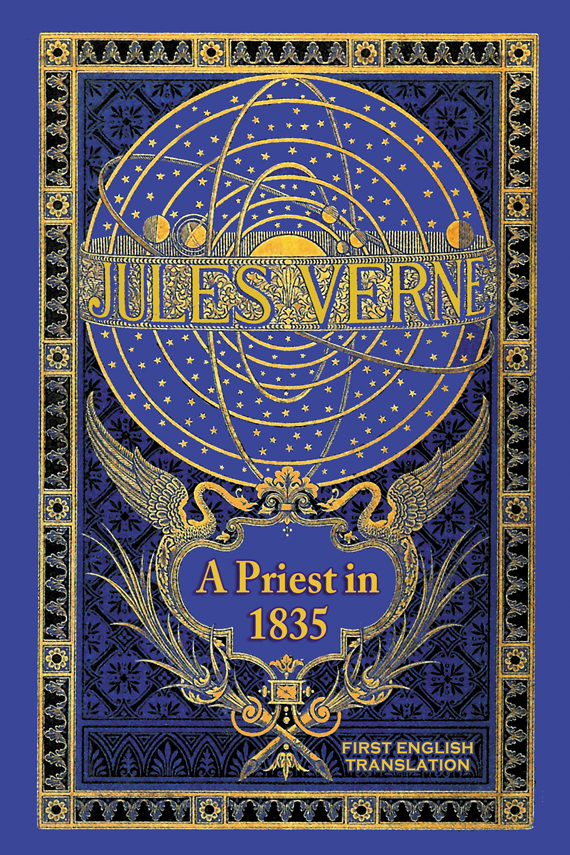
Here is not only a treasure, but a literary revelation - the very
first novel by Jules Verne. Finished by the age of 20 and under the influence of
Edgar Allan Poe, A Priest in 1835 was composed before Verne encountered any
editors to hone his storytelling skills. Yet this tyro effort is a masterpiece,
a novel told in a modernist style with a nonlinear narrative. This first English
translation, with extensive critical commentary, redeems A Priest in 1835
from the neglect and misunderstanding of French critics, who mistook its contemporary
approach for an unfinished work. Instead, Verne reveals that he had not only the
prophetic skills that would render him the father of science fiction, but a technique
that would win him a place among the vanguard of 21st century authors.
“Yesterday I received the Priest, and I already read the introduction and notes. Congratulations for this well-documented version, which is complementary to the French edition.”
— Volker Dehs, Renowned Jules Verne expert and biographer
“A remarkable achievement! This first English translation of Verne’s very first novel is a splendid volume. The North American Jules Verne Society has every reason to be proud.”
— Alex Kirstukas, translator, Verne’s Robur the Conqueror, Wesleyan University Press, 2017.
— “A Priest in 1835 by Jules Verne,” by Steve Joyce, Scarlet the Film Magazine, 25 July 2016.
A Priest in 1835 shows the influence of Edgar Allan Poe, which lasted through much of Verne’s life…. It soon becomes obvious that this is a detective story in the manner of Poe’s stories about C. Auguste Dupin published only a few year years previously…. All the main characters, including Pierre Herve, the priest of the title, are introduced in the first chapter and the mysterious events that will require explanation are also introduced. The reader is encouraged to keep track of the information that will make everything clear in the end…. Written at the beginning of Verne’s career, A Priest in 1835 is surprisingly mature in its style and structure…. A 64-page introduction discusses Verne’s debt to Poe in his earliest novel and the connection of the novel to his later works. It is a complex situation, and Danièle Chatelain and George Slusser do an excellent job to make it less complex. It is Verne’s skillful blend of detective and gothic fiction in this novel that leads to the scientific adventures that have come to be known to us as “science fiction.”
— J. Randolph Cox, “The Reference Shelf,” Dime Novel Round-Up, Vol. 85, Fall 2016, 124-125.
A Priest in 1835, by Jules Verne (BearManor). Devotees of Jules Verne will welcome this first English translation of his first novel, a mystery-laden romantic thriller produced when he was only 19. In a detailed introduction, the translators Danièle Chatelain and George Slusser summarize the work as “a highly original transformation of two popular 19th-century fictional modes — the Gothic and Poe’s fiction of ‘ratiocination.’” They argue that the novel demonstrates Verne’s rather postmodern conviction that “no investigation can be complete, that no amount of rational examination can ever exhaust the mystery that remains behind the surface of things.” This volume, richly illustrated, is part of the North American Jules Verne Society’s Palik series, which makes available in English hitherto neglected works.
— Michael Dirda, extracted from “A summer book list like no other: Michael Dirda picks 11 hidden gems,” Washington Post, 27 Jul 2016
Chatelain and Slusser make a brilliant case in their long Introductory Essay and in their extensive notes for the importance of this novel in the generation of Verne’s eventual “revolutionary” contribution to our popular culture with his “voyages extraordinaires” or modern sf. …they argue well that the eventual development of sf in Verne came from an unlikely mixture of elements from the Gothic novel combined with the analytic detective novel of Poe…
— Donald M. Hassler, extracted from “The Tangled Bank that Writers Inhabit: New Windows on Jules Verne,” The New York Review of Science Fiction, December 2016, Number 340, Vol. 29, No. 4, 25-29.
In its parts, however, with nods to the emerging detective story and to the declining Gothic tradition, it is often superb, offering early glimpses of the Verne whose writing is relished around the world and hints of the genre heritage that the author exploited in shaping his very best science fiction.
Here already Verne displays the sharp, ironic social commentary for which he has become ever more appreciated.
— Erik Rabkin, “Verne’s First Novel, Finally in English,” Extrapolation, Vol 58, April 2017.
Chatelain and Slusser end their introduction with a sub-chapter entitled “The Legacy of A Priest in 1835” in which they see, like [Christian Robin in the French edition], the influence of Priest in later Verne novels such as Journey to the Center of the Earth and Twenty Thousand Leagues Under the Seas. If Robin had added The Secret of Wilhelm Storitz, Chatelain and Slusser add Around the Moon and The Sphinx of the Ice, and even link Priest to the origins of science fiction:…Verne’s first neglected first novel provides a key element in understanding the origins of science fiction, how this genre came together, in the age of modern science, from Verne’s creative blending of available narrative forms.— Jean-Michel Margot, “Verne’s First Novel Finally in English,” Verniana, Vol 9 (2016-2017), p. 97-102.
— Jean Michel Margot, “Le Prêtre de Jules Verne en Anglais,” Bulletin de la Societe Jules Verne, No. 193 (2017), 31-35.
Volume 10 — The Castles of California
(The Castles of California, A Nephew from America)
Translated with an introduction and notes, by Kieran M. O’Driscoll; Appendix: Jules Verne’s Trip to America by Brian Taves.
Available at Amazon.com in paperback and hardcover editions.
(The Castles of California, A Nephew from America)
Translated with an introduction and notes, by Kieran M. O’Driscoll; Appendix: Jules Verne’s Trip to America by Brian Taves.
Available at Amazon.com in paperback and hardcover editions.
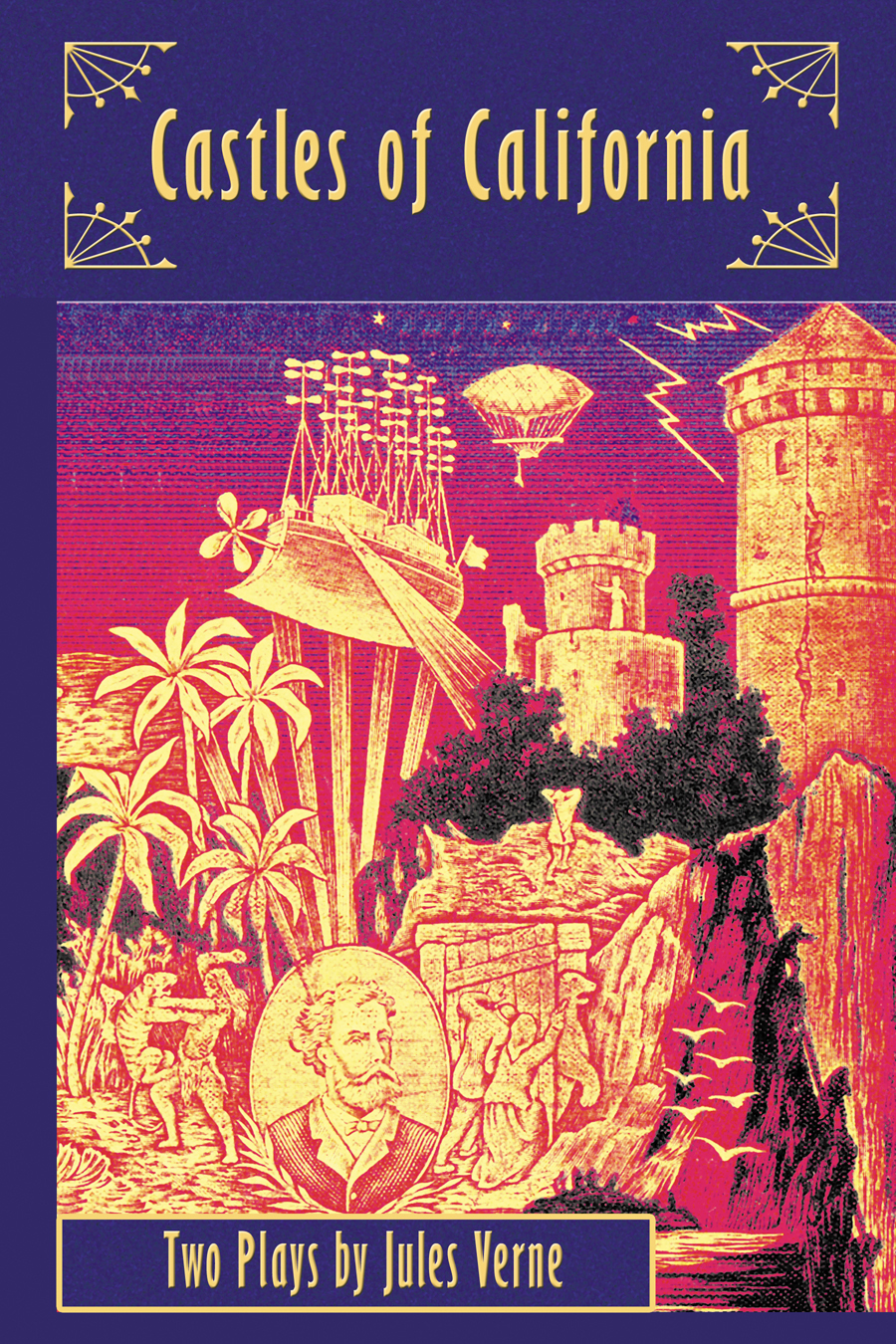
Two of Jules Verne’s plays have long piqued the interest of
American readers, and are included in this volume together in translation for the first
time. Both feature Frenchmen, recently returned from the United States, and each play is a
meditation on the ephemeral nature of wealth. In The Castles of California, the
Frenchman is returning from the California gold fields—has he struck it rich? Or is his
fate akin to that of most of the “Forty-niners”? In A Nephew from America,
a man of wealth and no family ties, known for his way with the ladies, suddenly discovers
that his late brother had a son in America, who is now an adult. And his new nephew is in love,
and needs his uncle’s assistance. Will true love, and true kinship, win out?
Accompanying the two plays is an afterword on Verne’s 1867 trip to the United States, and its lasting inspiration; some one-third of the author’s stories would include American characters, settings, or themes.
Accompanying the two plays is an afterword on Verne’s 1867 trip to the United States, and its lasting inspiration; some one-third of the author’s stories would include American characters, settings, or themes.
“Another splendid addition to the series”
— Alex Kirstukas, translator, Verne’s Robur the Conqueror, Wesleyan University Press, 2017.
Volume 11 — Scheherazade’s Last Night and Other Plays
(An Excursion at Sea, The Thousand and Second Night, and Le Guimard)
Translated, with notes, by Peter Schulman
Available at Amazon.com in paperback and hardcover editions.
(An Excursion at Sea, The Thousand and Second Night, and Le Guimard)
Translated, with notes, by Peter Schulman
Available at Amazon.com in paperback and hardcover editions.
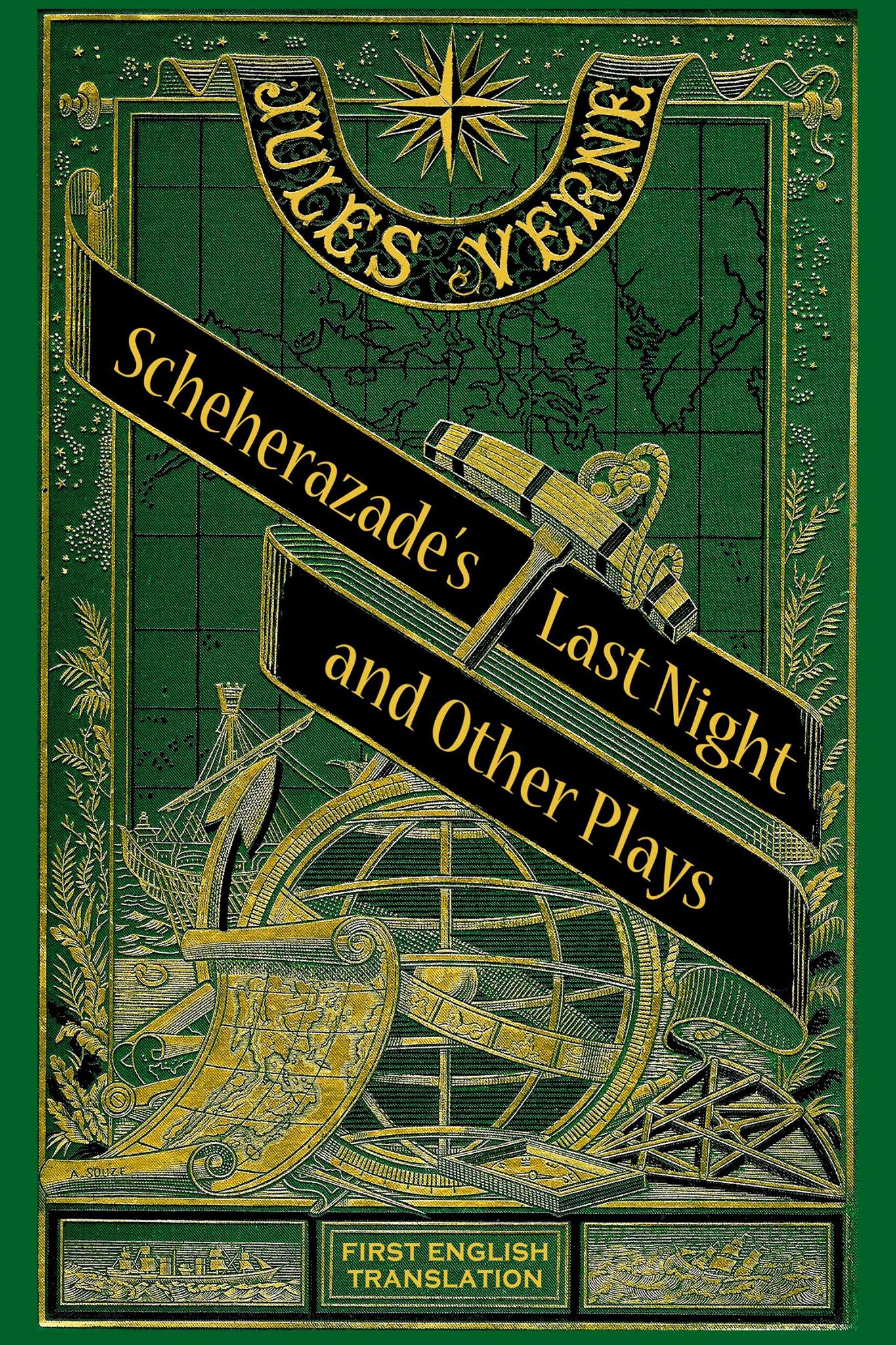
Jules Verne, before he became the famous novelist we know today from Around the World in 80 Days, learned his profession writing for the stage. Many of those youthful plays have been discovered for the first time, and three are translated into English for the first time in Scheherazade’s Last Night and Other Plays. In An Excursion at Sea, Verne offers a humorous account of a nautical adventure interrupted by pirates, foreshadowing many of his classic stories. In La Guimard, he relates a love affair between the dancer, and the painter Jacques-Louis David, creating a realistic historical background as well as a deeply-felt romance. And in The Thousand and Second Night, Verne draws upon the world of the Arabian Nights to tell how the Sultan and the story-telling Scheherazade are finally united in marriage.
“In the middle of the 19th Century, Jules Verne was learning to be a writer and composing plays, three of which are translated here into English for the first time. In this volume, the reader will discover how important Verne’s stage apprenticeship was to his authoring of world-famous novels. The stage was Verne’s first love, and in this trio of works he explores pirates at sea, Arabian Nights, and a real-life story of court intrigue between a painter and dancer.”
— Jean-Michel Margot, author of critical commentary for Verne’s The Marriage of a Marquis, Mr. Chimp & Other Plays, Journey Through the Impossible, and The Kip Brothers.
Volume 12 — Worlds Known and Unknown
(“Recollections of My Childhood and of My Youth,” “To the New Bride Caroline,” “A Voyage in a Balloon,” “About the Géant,” “Twenty-Four Minutes In A Balloon,” “Frritt–Flacc,” “Gibraltar,” “The Humbug: The American Way Of Life,” Mona Lisa, Zigzags Through the World of Science)
Translated by Kieran M. O’Driscoll, Edward Baxter, Alex Kirstukas, Ian Thompson
Available at Amazon.com in paperback and hardcover editions.
(“Recollections of My Childhood and of My Youth,” “To the New Bride Caroline,” “A Voyage in a Balloon,” “About the Géant,” “Twenty-Four Minutes In A Balloon,” “Frritt–Flacc,” “Gibraltar,” “The Humbug: The American Way Of Life,” Mona Lisa, Zigzags Through the World of Science)
Translated by Kieran M. O’Driscoll, Edward Baxter, Alex Kirstukas, Ian Thompson
Available at Amazon.com in paperback and hardcover editions.
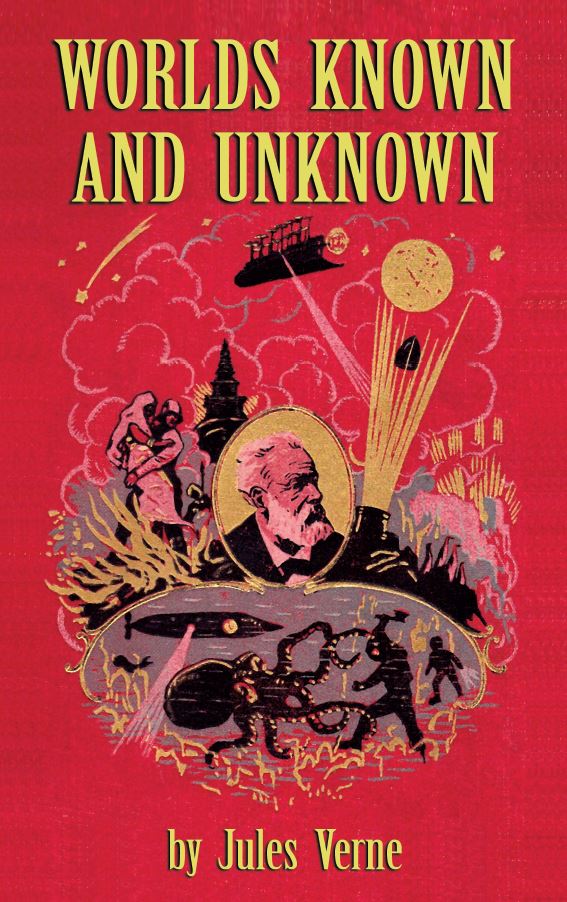
Jules Verne’s series of science fiction and adventure tales, the “Extraordinary Journeys,” were subtitled “Worlds Known and Unknown,” so that is an appropriate title for this volume of the Palik Series, edited by the Nortth American Jules Verne Society and devoted to the author’s stories not previously translated for the English-speaking world. Worlds Known and Unknown is an anthology featuring a variety of astonishing shorter works, with background and illustrations chosen from the original engravings that accompanied the first French publications. Beginning with his own adventures, Verne recounts several harrowing balloon ascensions, followed by a ghostly tale, and two satires of evolution—a man leading an army of apes, and a P.T. Barnum-type huckster unearthing a prehistoric human giant in New York! Here also is Verne’s stage recreation of the love between Mona Lisa and Leonardo da Vinci, and a series of fantastic stories by Jules Verne’s son and collaborator, Michel Verne.
 © 1993 - 2025 North American Jules Verne Society, Inc. — a 501(c)(3) Corporation
© 1993 - 2025 North American Jules Verne Society, Inc. — a 501(c)(3) Corporation